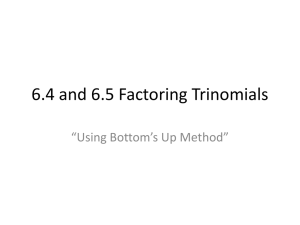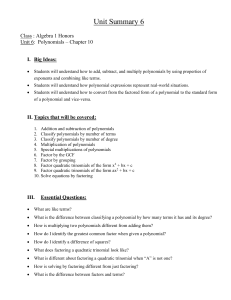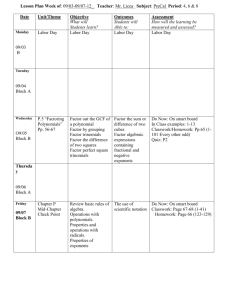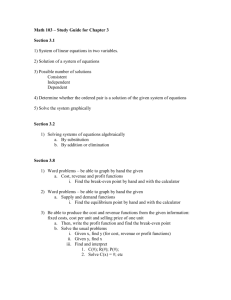Ch. 8 Notes
advertisement
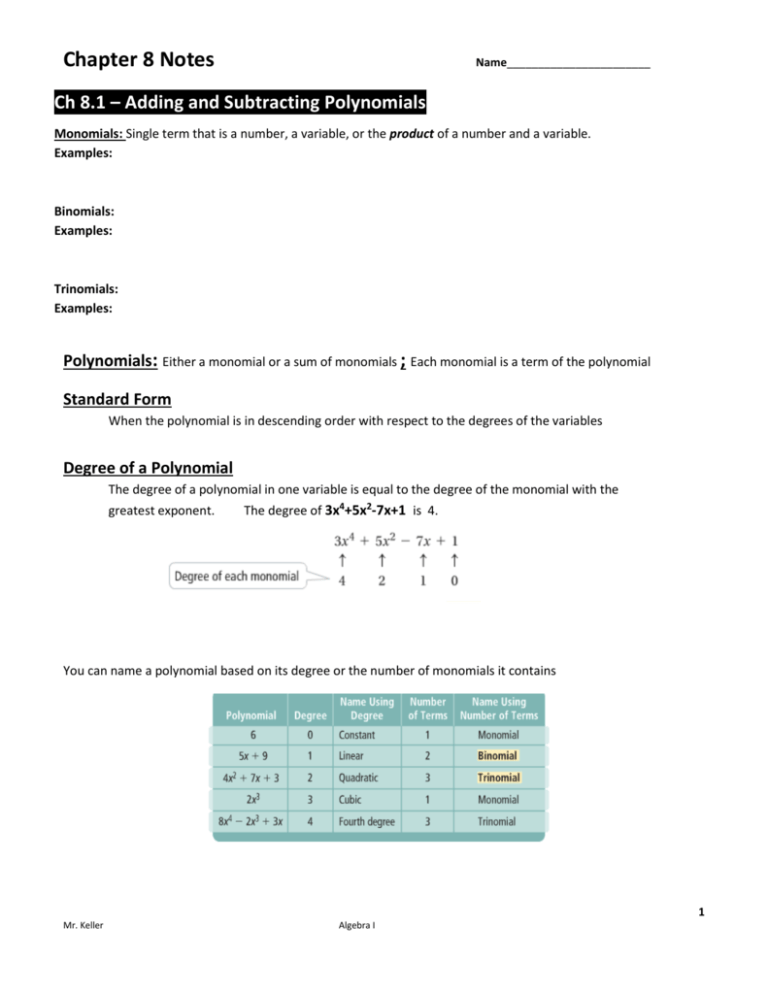
Chapter 8 Notes Name_______________________ Ch 8.1 – Adding and Subtracting Polynomials Monomials: Single term that is a number, a variable, or the product of a number and a variable. Examples: Binomials: Examples: Trinomials: Examples: Polynomials: Either a monomial or a sum of monomials ; Each monomial is a term of the polynomial Standard Form When the polynomial is in descending order with respect to the degrees of the variables Degree of a Polynomial The degree of a polynomial in one variable is equal to the degree of the monomial with the greatest exponent. The degree of 3x4+5x2-7x+1 is 4. You can name a polynomial based on its degree or the number of monomials it contains 1 Mr. Keller Algebra I Chapter 8 Notes Name_______________________ Adding and Subtracting Polynomials Group like terms by rearranging the polynomial Examples: Add the following polynomials 5) (3x2 – 4x + 8) + (2x – 7x2 – 5) 6) (7y2 + 2y – 3) + (2 – 4y + 5y2) Examples: Subtract the following polynomials. (REMEMBER TO DISTRIBUTE THE “NEGATIVE” TO THE QUANTITY) 7) (3x2 – 4x + 8) - (2x – 7x2 – 5) 8) (7y2 + 2y – 3) - (2 – 4y + 5y2) 2 Mr. Keller Algebra I Chapter 8 Notes Name_______________________ Ch 8.2 – Multiplying and Factoring Multiplying a Polynomial by a Monomial Remember the rules for exponents….. x (x2) = x 1+2 = x3 Distributive property: x 5(x + 3) 5(x) + 5(3) 5 (x + 3) x = __5x + 15______ Examples: Find the product of the following. 1) -2x2(3x2 – 7x + 10) 2) 4a(a2 + 9) Examples: Simplify the following expressions. 3) 4(3d2 + 5d) – d(d2 -7d + 12) 4) 3(2t2 – 4t – 15) + 6t(5t + 2) Factors and Greatest Common Factor 3 Mr. Keller Algebra I Chapter 8 Notes Name_______________________ Prime Number – number that can only be divided by itself and one; has only 2 factors Ex: 1, 2, 3, 5, 7, 11, 13… Composite Number- number that has more than 2 factors Ex: 4, 6, 8, 9, 10… Prime Factorization – when a whole number is expressed as a product of prime numbers THINK FACTOR TREE You must factor out a -1 when factoring negative numbers. Factored Form: expressed as a product of prime numbers and variables with degree 1 Example: Factor completely: 6x3y 2(3)(x)(x)(x)(y) Greatest Common Factor – greatest term that divides into a number or monomial - factor completely and circle like factors WHAT DOES EVERY TERM HAVE IN COMMON????? / WHAT CAN YOU DIVIDE EVERYTHING BY???? Examples: Find the GCF of the following 5) 18xy + 24y2 6) 10x - 15 7) -14x3y2 - 16x4y3 Examples: Factor the polynomial. (Find the GCF and divide it out) EX: 3x2 + 6x + 9 factors into 3(x2 + 2x + 3) 8) 9x + 6 9) -15x2 – 25x 10) 5k3 + 20k2 – 15k Ch 8.3 – Multiplying Binomials (F.O.I.L.) or BOX Method 4 Mr. Keller Algebra I Chapter 8 Notes Name_______________________ FOIL Method FOR USE ONLY WHEN MULTIPLYING BINOMIALS First terms in each binomial are multiplied Example: (x + 4)(x + 3) Outer of the four terms are multiplied F O I L Inner of the four terms are multiplied x(x) x(3) 4(x) 4(3) Last terms of each binomial are multiplied x2 +3x +4x +12 x2 + 7x + 12 BOX Method Create a 2 x 2 box and label each part with a term from each binomial (x + 4)(x + 3) x 4 x 3 x(x) 3(x) (4)x 3(4) x2 + 4x + 3x + 12 x2 + 7x + 12 Example: Find the product of the following 1) (x + 3)(x + 5) 2) (x + 4)(x – 3) 3) (x – 5)(x + 7) 5) (2x – 5)(3x2 – 4x + 1) 4) (2n + 3g)(4n – 5g) 5 Mr. Keller Algebra I Chapter 8 Notes Name_______________________ Ch 8.4 – Multiplying Binomials - Special Cases Square of a Sum 2 2 Square of a Difference 2 2 2 (a + b) = a + 2ab + b (a – b) = a – 2ab + b 2 2 2 (x + 3) = x + 2(x)(3) + (3) = x2 + 6x + 9 What does the expression 33 mean to do? Rewrite it: Rewrite the expression x5 without exponents: How can we rewrite (x + 2)2 without exponents: 2 Sum and a Difference (a + b)(a – b) = a2 – b2 How can knowing this trick, help you with simplifying an expression then? Example: Simplify the following 6) (x + 7)2 7) (2x - 3y)2 8) (x – 4)(x + 4) 9) (3x – 9y)(3x + 9y) 8.5 – 8.8:Factoring Quadratics 6 Mr. Keller Algebra I Chapter 8 Notes Name_______________________ Factoring By Grouping: works for polynomials with 4 terms or more; use the method above to factor Group terms with like variables together and factor by distributive property Steps for Factoring: 1. Factor out any common terms first (i.e….Is there anything they all divide by) 2. Mutliply the First Coefficient by the Last Term (i.e. the # in front of x2 by the number with no variable) 3. Find 2 factors of that product that add to the “x” term 4. Rewrite the middle term as the sum of the 2 factors 5. Factor by Grouping (Split the 4 terms into 2 sets of 2) 6. Write the final answer as 2 quantities (x + a)(x – b) Example: x2 + 5x + 6 1(6) = 6 Factors of 6 that add to 5 = 3 and 2 Rewrite: x2 + 3x + 2x + 6 Grouping: x2 + 3x + 2x + 6 x(x + 3) +2(x + 3) ---Factor out the common terms on each side (x + 3) (x + 2) ---Take out quantity from each side and write what is left Examples: Factor the following. 1) 4ax – 5a Example: Factor 3) 4ab + 8b + 3a + 6 6) 2x2 + 4x + 8x + 16 2) 3xy + 12y 4) 3ab – 15a + 4b – 20 5) 2xy + 7x – 4y – 14 7) 3x3 + 3x2 + 12x2 + 12x WHAT HAPPENS WHEN THERE ARE NOT 4 TERMS ALREADY???? Steps for Factoring: 7 Mr. Keller Algebra I Chapter 8 Notes Name_______________________ 1. Factor out any common terms first (i.e….Is there anything they all divide by) 2. Create the 2x2 box again. The x2 term goes in the upper left corner and the constant term goes in the lower right corner. 3. Multiply the coefficient of the x2 and the constant term. 4. Find factors of that number that add the middle term of the quadratic. 5. Place those factors in the other 2 boxes with variables. 6. Factor out the GCF and complete the sides. Example: Factor the following 8) x2 + 6x + 8 9) x2 + 5x + 4 10) x2 + 7x + 12 11) x2 – 10x + 16 12) x2 – 12x + 27 13) x2 + x – 12 14) x2 – 7x – 18 15) x2 – x – 20 16) x2 – 8x - 20 Ch 8.6 – Factoring Trinomials when a ≠ 1 8 Mr. Keller Algebra I Chapter 8 Notes Name_______________________ ALWAYS LOOK FOR A GCF TO TAKE OUT FIRST!!! Factoring Trinomials where a ≠ 1 - must be in the form ax2 + bx + c - has a coefficient in front of x2 Steps for Factoring: 1. Factor out any common terms first (i.e….Is there anything they all divide by) 2. Create the 2x2 box again. The x2 term goes in the upper left corner and the constant term goes in the lower right corner. 3. Multiply the coefficient of the x2 and the constant term. 4. Find factors of that number that add the middle term of the quadratic. 5. Place those factors in the other 2 boxes with variables. 6. Factor out the GCF and complete the sides. Example: 7x2 + 22x + 3 → 7(3) = 21 → Factors 1 3 of 21 21 7 Sum of Factors 22 10 → Examples: Factor 1) 5x2 + 27x + 10 2) 10x2 - 43x + 28 **4) 3x2 + 24x + 45 3) 2x2 + 7x + 5 ***5) 12x2 + 20x - 8 Ch 8.7 – Factoring Special Cases 9 Mr. Keller Algebra I Chapter 8 Notes Name_______________________ REMEMBER TO LOOK FOR GCF!!!! Remember: (x + y)(x – y) = x2 – y2 Factoring a Difference of Squares Therefore: x2 – y2 – (x – y)(x + y Examples: Factor the following 1) x2 – 25 5) 3x3 – 27x 2) m2 – 64 3) 4x2 – 9y2 6) 16x2 – 16 4) 36x2 – 81y2 7) 5x3 + 15x2 – 5x - 15 Perfect Square Trinomials – trinomials that are a square of a binomial 10 Mr. Keller Algebra I Chapter 8 Notes Name_______________________ first and last term are prefect squares middle term is two times the root of the first term times the root of the last term When factoring and you multiply the 1st and last terms together: If it is a huge number, take the square root of it, that will tell you what to fill the box with. Examples: Factor the following. 8) 16x2 – 72x + 81 9) 4x2 + 20x + 25 10) 81r2 – 90r + 25 11 Mr. Keller Algebra I



